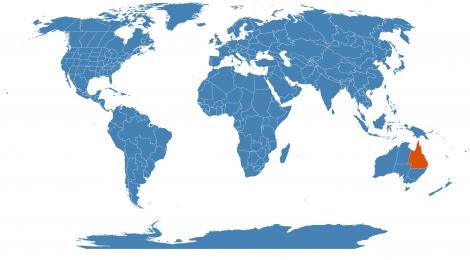Accession Data:
Austrobaileya scandens C.T. White
- Common Name:
- Family: Austrobaileyaceae (Croiz.) Croiz.
- Country of Origin: Queensland (Cook, North Kennedy)

- Habitat: Daintree Rainforest endemic - Mesophyll / notophyll vine forest
- Description: Evergreen, woody vines with loosely twining main stem and straight, leafy lateral branches endemic to the rainforests of northeast Queensland, Australia. This species is one of two species in the genus and the genus is the only member of the family, Austrobaileyaceae. It is a very primitive angiosperm family although it is sometimes placed in the Magnoliales (Cronquist) or Laurales. Cronquist considers it an "isolated small group, not wholly compatible with the bulk of either the Laurales or Magnoliales, but not sufficiently distinctive to constitute a family of its own."
The flowers are rather large, solitary in the axils of the leaves, with a putrescent odor, probably pollinated by flies.
Its pollen is the oldest recorded flowering plant pollen in Australia.
- Culture: Austrobaileya foliage tends to 'burn' in direct sunlight, so it prefers to stay well beneath the rainforest canopy where it enjoys living in low-sunlight, wet and damp areas.
Also appears quite susceptible to burning from soaps, oils and emulsifiable carriers.
NOTE: "... Austrobaileya used to flower only sporadically in lower light and warmer conditions in the greenhouses. After placing the plant to a brighter position where it receives a slight winter chill (50F) nights the plant now flowers annually and quite prolifically...
Personal communication with Marc Hachadourian - NYBG
- USDA Zone: 9-11?
Accession Data:
- Accession # 200202459
- Source: Tim Devine - CSU Chico
- Provenance:
CSU Chico ex UC Berkeley BG# 72.615 ex Arnold Arboretum. This makes this accession the same clone as 200201878 but will keep both as backup against loss. See Arnoldia, Volume 38 Number 3 – May 1978 (link below) for more information on original provenance.
- Accession Date: 10-17-2002
- Bench: 3108 - EVO: Basal Angiosperms
- Currently: active - healthy
- Qty: 2 confirmed on 11-29-2024
Classification:
- Division: Magnoliophyta
- Class: Magnoliopsida
- SubClass: basal angiosperms
- Order: Austrobaileyales
- SubOrder:
- Family: Austrobaileyaceae
- SubFamily:
- Tribe:
- SubTribe:
Flowering Data:
This accession has been observed in bloom on:| Year | Jan | Feb | Mar | Apr | May | Jun | Jul | Aug | Sep | Oct | Nov | Dec | ||||||||||||||||||||||||||||||||||||||||
|---|---|---|---|---|---|---|---|---|---|---|---|---|---|---|---|---|---|---|---|---|---|---|---|---|---|---|---|---|---|---|---|---|---|---|---|---|---|---|---|---|---|---|---|---|---|---|---|---|---|---|---|---|
| 2024 | ||||||||||||||||||||||||||||||||||||||||||||||||||||
| 2023 | ||||||||||||||||||||||||||||||||||||||||||||||||||||
| 2022 | ||||||||||||||||||||||||||||||||||||||||||||||||||||
| 2021 | ||||||||||||||||||||||||||||||||||||||||||||||||||||
| 2020 | ||||||||||||||||||||||||||||||||||||||||||||||||||||
| 2019 | ||||||||||||||||||||||||||||||||||||||||||||||||||||
| 2018 | ||||||||||||||||||||||||||||||||||||||||||||||||||||
| 2017 | ||||||||||||||||||||||||||||||||||||||||||||||||||||
| 2016 | ||||||||||||||||||||||||||||||||||||||||||||||||||||
| 2015 | ||||||||||||||||||||||||||||||||||||||||||||||||||||
| 2014 | ||||||||||||||||||||||||||||||||||||||||||||||||||||
| 2013 | ||||||||||||||||||||||||||||||||||||||||||||||||||||
| 2012 | ||||||||||||||||||||||||||||||||||||||||||||||||||||
References (internal):
- Basal Angiosperms (paleodicots)
- Fly pollination (myophily and sapromyophily)
- EEB 3271 - Systematic Botany
- EEB Greenhouse Holdings native to: Queensland
References (external):
- Wikipedia
- Weaver, R.E., Notes from the Arnold Arboretum: Austrobaileya, Arnoldia, Volume 38 Number 3 – May 1978
- The Plant List (2013). Version 1.1. Last accessed on Monday, July 31, 2017.
- WCSP (2016). World Checklist of Selected Plant Families. Facilitated by the Royal Botanic Gardens, Kew. Last accessed on Monday, July 31, 2017.
data regenerated on Fri, 29 Nov 2024 10:24:35 -0500 [bcm v4.0]
Images:

Additional images for this accession:
Click on thumbnails to enlargeCurrent Accessions in the Austrobaileyaceae
W/C = Wild Collected = indicates flowering in past 14 days
= indicates flowering in past 14 days
 = images available for this accession
= images available for this accession
 = map available for this accession
= map available for this accession
 = accession added within past 90 days
= accession added within past 90 days


